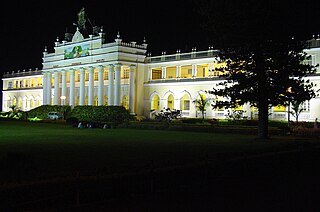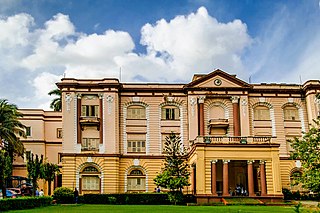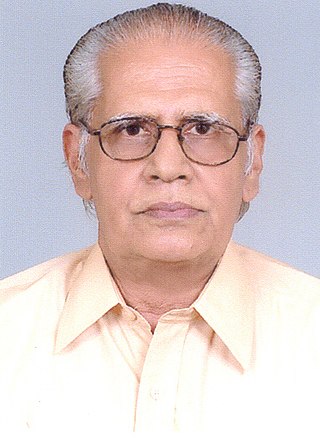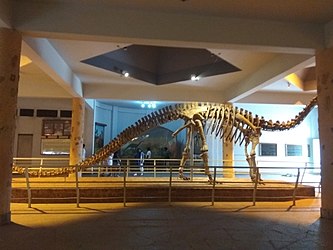
Osmania University is a collegiate public state university located in Hyderabad, Telangana, India. Mir Osman Ali Khan, the 7th Nizam of Hyderabad, issued a firman calling for its creation on 29 August 1917. It is the third oldest university in southern India, and the first to be established in the erstwhile Kingdom of Hyderabad. It was the first Indian university to use Urdu as a language of instruction, although with English as a compulsory subject. As of 2012, the university hosts 3,700 international students from more than 80 nations.

The University of Mysore is a public state university in Mysore, Karnataka, India. The university was founded during the reign of Maharaja Krishnaraja Wadiyar IV and the premiership of Sir M. Visvesvaraya. The university is recognised by the University Grants Commission for offering higher studies degree courses on-campus as well as online. It was inaugurated on 27 July 1916. Its first chancellor was the maharaja himself; the first Vice-Chancellor was H. V. Nanjundaiah. This was the first university outside of British administered Indian provinces, the sixth in the Indian subcontinent as a whole, and the first in Karnataka. It is a state university of the affiliating type, and was deemed autonomous within the Republic of India on 3 March 1956, when it gained recognition from the University Grants Commission.

The Indian Space Research Organisation, commonly referred to as ISRO, is the national space agency of India. It operates as the primary research and development arm of the Department of Space (DoS), which is directly overseen by the Prime Minister of India, while the Chairman of ISRO also acts as the executive of DoS.

Vikram Ambalal Sarabhai was an Indian physicist and astronomer who initiated space research and helped develop nuclear power in India.

Sankara Nethralaya is a not-for-profit missionary institution for ophthalmic care headquartered in Chennai, India. In the name "Sankara Nethralaya", "Sankara" is a reference to Lord Shiva and "Nethralaya" means "The Temple of the Eye". Sankara Nethralaya receives patients from India and abroad. Sankara Nethralaya has over 1000 employees and serves around 1500 patients per day, performing over 100 surgeries per day. The annual revenue as per the taxes is close to US$100 million.

The Launch Vehicle Mark-3 or LVM3 is a three-stage medium-lift launch vehicle developed by the Indian Space Research Organisation (ISRO). Primarily designed to launch communication satellites into geostationary orbit, it is also due to launch crewed missions under the Indian Human Spaceflight Programme. LVM3 has a higher payload capacity than its predecessor, GSLV.

Gaganyaan is an Indian crewed orbital spacecraft intended to be the formative spacecraft of the Indian Human Spaceflight Programme. The spacecraft is being designed to carry three people, and a planned upgraded version will be equipped with rendezvous and docking capabilities. In its maiden crewed mission, the Indian Space Research Organisation (ISRO)'s largely autonomous 5.3-metric ton capsule will orbit the Earth at 400 km altitude for up to seven days with a two- or three-person crew on board. The first crewed mission was originally planned to be launched on ISRO's LVM3 in December 2021, But this has since been delayed to no earlier than 2025.


National Council of Science Museums (NCSM) is an autonomous organisation under Indian Ministry of Culture. It is the largest chain of science centers or museums under a single administrative umbrella in the world. There are 24 own science centers or museums and one R & D laboratory and training centre of NCSM, located in different states in India. Functioning under the Ministry of Culture, the NCSM has been built to co-ordinate all informal science communication activities in the museum space in the country. Its raison d'etre is specified on the website as described in the section 'Genesis':

Birla Industrial & Technological Museum (BITM) is a science museum in Kolkata, West Bengal, India. It is a unit under National Council of Science Museums (NCSM), Ministry of Culture, Government of India. Under the governmental jurisdiction of the Council of Scientific & Industrial Research (CSIR), BITM is commonly recognized as the precursor of India's science museum concept.

B. M. Birla Planetarium is a large planetarium in Chennai, India. The fifth B. M. Birla planetarium in the country, it is located at Kotturpuram in the Periyar Science and Technology Centre campus which houses eight galleries, namely, Physical Science, Electronics and Communication, Energy, Life Science, Innovation, Transport, International Dolls and Children and Materials Science, with over 500 exhibits. Built in 1988 in the memory of the great industrialist and visionary of India B. M. Birla, it is considered the most modern planetarium in India, providing a virtual tour of the night sky and holding cosmic shows on a specially perforated hemispherical aluminium inner dome. Other Birla planetariums in India include the M. P. Birla Planetarium in Kolkata, the Birla Planetarium in Hyderabad, and the planetariums in Tiruchirapalli and Coimbatore.

The Birla Planetarium in Kolkata, West Bengal, India, is a single-storeyed circular structure designed in the typical Indian style, whose architecture is loosely styled on the Buddhist Stupa at Sanchi. Situated at Chowringhee Road adjacent to the Victoria Memorial, St. Paul's Cathedral and the Maidan in Central Kolkata, it is the largest planetarium in Asia and the second largest planetarium in the world. There are two other Birla Planetariums in India: B.M. Birla Planetarium in Chennai and the Birla Planetarium in Hyderabad.

Geo Imaging Satellite or GISAT is an Indian imaging satellite class for geostationary orbit with a high temporal resolution, meant for providing near real time imaging with fast revisit capability and real time monitoring. Two satellites will provide resolution in the range of 42 to 318 m. It will carry multi-spectral, multi-resolution imaging instruments.

P. V. Manoranjan Rao is a veteran space scientist and author from India. In his career spanning over three decades — including over two decades at the Indian Space Research Organisation's Vikram Sarabhai Space Centre — he has done extensive research in areas including the physics of lightning discharge, ionospheric physics, magnetospheric physics, VLF and ELF wave propagation, electrostatics of launch vehicles, electrostatic charging of communications satellites, EMI/EMC and lightning protection for launch vehicles. He has edited and authored three books on India's space history.

The Statue of Equality is a statue of the 11th-century Indian philosopher Ramanuja, located on the premises of the Chinna Jeeyar Trust at Muchintal, Ranga Reddy district in the outskirts of Hyderabad. It is the second tallest sitting statue in the world. The project of building the statue was conceptualised by the trust to commemorate 1,000 year birth anniversary of Ramanuja, costing an estimated ₹1,000 crore (US$130 million), the project was paid for through the donations of devotees in a major part.
DRDO Young Scientist Laboratories (DYSLs) are five specialised research laboratories located in five different cities of India, inaugurated by the Prime Minister of India on 2 January 2020. Each laboratory deals with a focused area of science - artificial intelligence, quantum technologies, cognitive technologies, asymmetric technologies and smart materials. The labs are located in Bengaluru, Mumbai, Chennai, Kolkata and Hyderabad. As per the norms laid out, everyone, including director, at the labs is under 35 years of age. DRDO Chairman G.Satheesh Reddy conveyed to The Hindu on 3 January 2020 that the laboratories are formally operational.

Pranav Sharma is an astronomer and science historian known for his work on the history of the Indian Space Program. He has curated Space Museum at the B. M. Birla Science Centre. He was the in-charge of the history of the Indo-French scientific partnership project supported by the Embassy of France in India. He is a national award-winning science communicator and has extensively worked in the popularization of astronomy education in India. He is the Co-Lead on the History of Data-Driven Astronomy Project. He also serves as the Policy and Diplomacy Advisor to United Nations International Computation Centre, Advisor to the France India Foundation, Scientific Advisor to Arc Ventures, Science Diplomacy Consultant to Indian National Science Academy and Member Secretary for G20-Science20. He has co-authored the book Essential Astrophysics: Interstellar Medium to Stellar Remnants, CRC Press, 2019.
Brij Mohan Birla was one of the scions of Birla family and a noted Industrialist and philanthropist. He was the youngest and 4th son of Baldeo Das Birla. He served as Chairman of Hindustan Motors, Ruby General Insurance, India Exchange Ltd, NBC Bearing and was on board of several other Birla companies. He founded Hindustan Motors in 1942 and NBC Bearings in 1946. CK Birla Group is successor to his branch of Birla family. He served as president of Indian Chamber of Commerce in 1936 and the Federation of Indian Chambers of Commerce & Industry for year 1954.




















